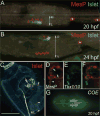Early chordate origins of the vertebrate second heart field
- PMID: 20671188
- PMCID: PMC4970750
- DOI: 10.1126/science.1190181
Early chordate origins of the vertebrate second heart field
Abstract
The vertebrate heart is formed from diverse embryonic territories, including the first and second heart fields. The second heart field (SHF) gives rise to the right ventricle and outflow tract, yet its evolutionary origins are unclear. We found that heart progenitor cells of the simple chordate Ciona intestinalis also generate precursors of the atrial siphon muscles (ASMs). These precursors express Islet and Tbx1/10, evocative of the splanchnic mesoderm that produces the lower jaw muscles and SHF of vertebrates. Evidence is presented that the transcription factor COE is a critical determinant of ASM fate. We propose that the last common ancestor of tunicates and vertebrates possessed multipotent cardiopharyngeal muscle precursors, and that their reallocation might have contributed to the emergence of the SHF.
Figures




References
-
- Buckingham M, Meilhac S, Zaffran S. Nat Rev Genet. 2005;6:826. - PubMed
-
- Abu-Issa R, Kirby ML. Annu Rev Cell Dev Biol. 2007;23:45. - PubMed
-
- Meilhac SM, Esner M, Kelly RG, Nicolas JF, Buckingham ME. Dev Cell. 2004;6:685. - PubMed
-
- Brade T, Gessert S, Kühl M, Pandur P. Dev Biol. 2007;311:297. - PubMed
-
- Gessert S, Kuhl M. Dev Biol. 2009;334:395. - PubMed
Publication types
MeSH terms
Substances
Grants and funding
LinkOut - more resources
Full Text Sources
Other Literature Sources
Medical
Research Materials

